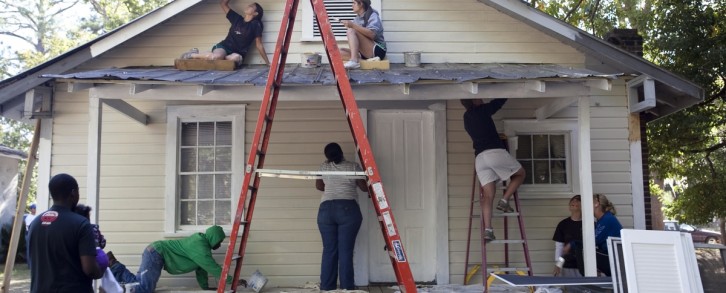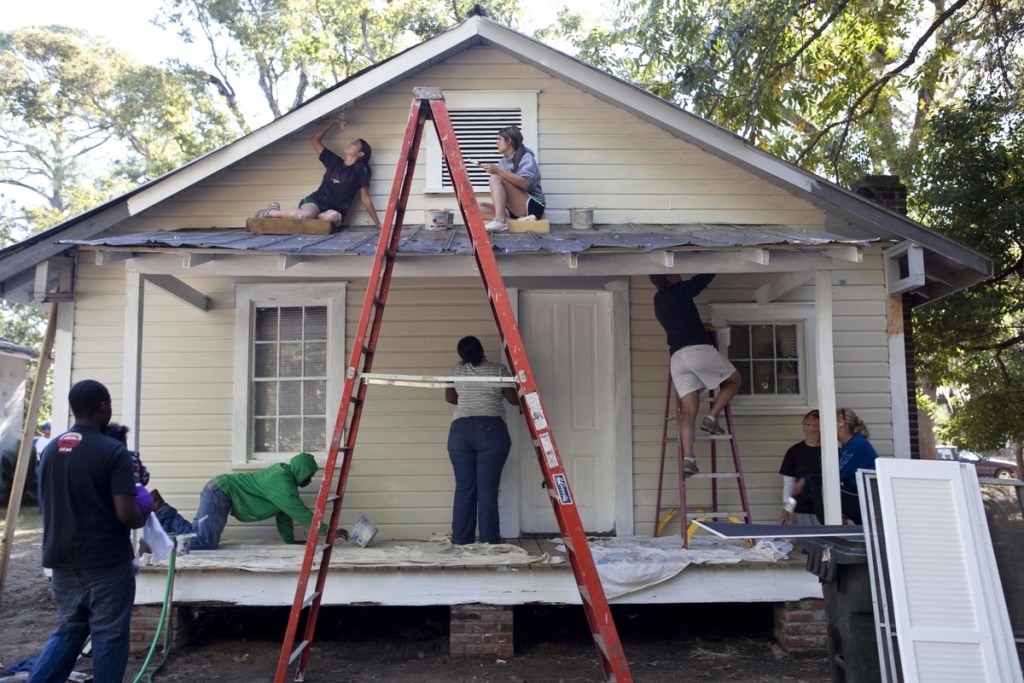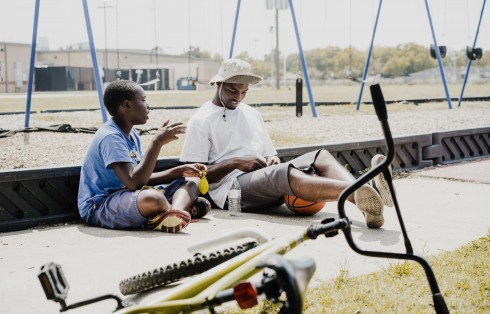Intergenerational Ministry Part 5: Develop Intergenerational Serving Ministries
In our first blog in the series , EM proposed 8 core suggestions on how a church might begin to rethink and redress this important but neglected area of church life, growth and health, and begin to re-strategise this ministry to the greater spiritual health and benefit of all believers, both young and old. The following is core suggestion 4 in the series: Develop Intergenerational Serving Ministries…
“Teens should not only be the objects of ministry;
they need to be the subjects of ministry as well” [1]
“I wish that more youth ministry was aimed at connecting students to the broader life of the church than simply having thrilling activities targeted at their generational desires. If students had greater connections to an intergenerational church ministry, their transition into college would be more widely guided and followed by others. This would help students to view their spiritual lives as less individualistic and more community-oriented. They would see that their spirituality is not about them alone, but about finding their place within the body of Christ” [2]
A. By broadening leadership teams
Both the literature and specialist interviews discussed in our ‘Retention and Transition’ paper raised the value of including parents and older adults on children’s and youth leadership teams:
“You need a variety of age groups involved in the kid’s ministry leadership (not just uni/school age group). For example, parents have a vital role in bringing experience and maturity, and they play a crucial role, not only with the kids but also with the younger leaders. Maturity is needed to give balance, and breadth of age helps the growth of young leaders”
The ideal is to have older and younger leaders paired in partnership with each other. They become ‘mentors’ for the kids and mentors for the leaders. And not just mentors in relation to children’s ministry but also in how to be a husband/wife or father/mother, which is so vital for young people and makes their leadership experience fuller. It helps them grow in godliness and wisdom.
It also needs to be a ‘family’ experience so that kids can see people of all ages following Jesus. Otherwise what the child sees is that you stay Christian until you are about 21 and then it drops off, and that Christians older than 30 have nothing to contribute. This is a bad model to see. They need to see there can be a passion for God, people and others their whole life” [3]
Likewise, Moser and Vernon also believe it’s important to have youth leadership teams that span generations, not just the immediate age above:
“Some of the best leaders around are actually a lot older than the norm. We often fall into the trap of thinking that a good leader is a young leader because they “can relate so well to the young people.” This is often misguided. Young people need leaders who will love them, listen to them, and show them Christ. Your age may be a minor detail. Besides, most kids can’t tell the difference between 25 and 55. If you are over 21, you are ancient!” [4]
The belief here is that something is seriously wrong if all leaders and mentors of children and youth are only ever drawn from within the late teen or twenty-something age bracket. The Bible itself often couches discipleship in multigenerational terms (e.g. Titus 2:1-8), suggesting that a network of spiritual grandparents, couples, college students, single adults, empty nesters, and widowers all provide the richest and most effective context for discipleship outside a biological family unit.
B. By cross generational serving in congregational life:
“We were welcomed not just in youth group; we were welcomed into other parts of the ministry of the church, whether it be in the worship or the praise team on Sunday mornings, or whether it be teaching Sunday school to kids or helping with cleaning or serving…all these other types of things really just brought the youth in and made them feel like they had a place and even feel like they were valued as individuals” [5]
Research suggested that another important way of bridging the intergenerational gap is that we must find ways to actively and intentionally include children, teens and young adults in serving within the congregational life of the church, rather than relegating them to back rooms, or passively sitting in the back pews. [6]
“Children need to contribute to the church. We need to recognize children’s gifts, skills and the ability to model the Christian faith to each other and us” [7]
Re-enforcing faith commitment means children, teenagers and young adults today need more public faith engagement, meaningful ‘rites of passage’ (such as confirmation, inclusion in praying, serving and bible reading in church) as well as given specific disciple-making responsibilities such as visiting the sick, teaching children by caring for, training, mentoring and discipling those younger in the faith than them. [8]
“I learned how to effectively model and shape a biblical view of the church for the youth. What was so different? To start, students were part of the church. Rather than a token “Youth Sunday,” we regularly had students serving as ushers, greeters, choristers, music volunteers, and Scripture readers. Some of our older teens were teaching Sunday school, and when the church gathered for various functions, teens joined in the mix. This was an intergenerational church family where relationships spanned decades and all ages served side by side. Sure, we had youth Bible study groups and other activities specifically for students, but that never precluded their involvement in the gathered church” [9]
Joiner believes that the spiritual formation of children and teenagers is closely connected to the act of serving in particular. That if we fail to help kids make a practical investment of time and energy into serving others, their hearts will never mature in learning to care for, and serve others (particularly as they transition towards high school and college). [10]
“It’s important to understand how closely spiritual formation is connected to the act of serving. If we fail to help kids make a practical investment of their time and energy in serving others, their hearts will never mature to care for others…Too many churches teach as if students should sit and listen instead of actually experiencing hands-on ministry” [11]
“By not only teaching me about the Bible, but allowing me to serve and lead, high school provided me with the necessary views of Christianity to really begin to seek my relationship with Christ on my own as I set out from home” [12]
Both children and teenagers need consistent practical opportunities to develop their faith, and guided hands on encounters with ministry that give them a personal sense of God’s mission, and opportunities to influence others growth in the kingdom. [13]
These practical opportunities could be anything from serving as ushers, welcomers, bible readers, prayers, musicians, crèche assistants, kids Sunday school teachers, art or digital creative etc, through to simply performing everyday tasks together with adults.
One church decided to offer all children who graduated to adult church, what they called a – ‘Service Opportunity’, which meant that for at least a year they had a specific serving ministry in the church:
“These are the same ministry opportunities that adult members are offered, and include things like ushering, collection taking, sound desk, taking around communion, assisting with the younger children in Children’s Ministry and being part of the worship team. Being involved in this ‘Service Opportunity’ offers the children an informal mentoring process with the individual adults with whom they work alongside in the church for that year. The children are seen by the adults to be apprentices and their role also to build relationships and offer affirmation as well as working with the children” [14]
In this way, children learn alongside adults, that the call to serve God’s church, to serve the body, is a call made to every believer, great or small:
“Churches have the potential to turn a generation around by handing them the keys to ministry and saying, “Guess what? Not only do we need your help, but God designed you and God created you for this very reason. You were called to use your gifts as much as the Pastor was called to use his. Each one of us has a personal responsibility to be the church, and if you recognise that, it will revolutionize your life” [15]
Apart from serving the body of Christ, as every disciple is called to do, doing simple serving tasks together with adults breaks down the ‘awkward’ age barrier like little else might:
“I don’t meet any adults who want nothing to do with kids, but I meet a lot of adults who are intimidated by teenagers and don’t know how to talk with them. Serving together levels the ground. When we’ve got a hammer in one hand and a paintbrush in the other, all of a sudden we’ve created a shared experience, and age is irrelevant” [16]
C. By youth serving and building relationships with those younger in the faith:
As already mentioned, research found that intergenerational contact and engagement for youth and children with those younger than themselves was also very important in faith development and longevity. [17]
Research suggests that teens and young adults who serve and build relationships with children younger than themselves were also more likely to hang on to their faith. [18]
Perhaps by sharing their faith with those younger, answering younger children’s doubts and questions enabled them to reinforce their own faith, or perhaps serving in the church made them feel more part of church life and community, or giving them an opportunity to explore their own spiritual gifts and abilities enabled them to make a contribution to the body of Christ? Whatever the reason, research indicates that serving and building relationships with those younger than themselves had an impact that solidified faith.
NEXT POST: The next post in the series will be – ‘Rethink the Place of Church Wide Services’.
Other blogs in this series:
* Intergenerational Ministry Part 1: ‘Why Intergenerational Ministry’
* Intergenerational Ministry: Part 2: ‘Carefully Manage Age Segregation’
* Intergenerational Ministry Part 3: ‘Build Social Capital’
* Intergenerational Ministry Part 4: ‘Create Structures that Span Life Stages’
* To download a full copy of E.M’s research on this topic head to the ‘Intergenerational Ministry’ page on this website.
[1] ‘Is The Era Of Age Segmentation Over?’(Leadership Journal).
[2] E. Hunter: ‘Preparation for the Journey’ (Youth Worker Website).
[3] B. Linton: (Children’s Minister, Sydney).
[4] K. Moser: Changing The World Through Effective Youth Ministry.
[5] Dr K.E. Powell and Dr. C. Clark: Sticky Faith.
[6] D. Goodwin: Lost in Transition- or Not? ‘Addressing the problem of Children Leaving the Church as they Make the Transition from Childhood to Youth’
[7] T. Beilharz:‘Developing a Theology of Children’.
[8] Slater makes the point that we need to allow young people and children to make a contribution to the life of the church. That when Paul writes of the gifts of the risen Jesus has entrusted to the church, there’s no indication that the works of service produced by these gifts are restricted to those over eighteen. The use of gifts is also a great way to cultivate right attitudes and maturity in the young. A. Mitchell: FAQ’s: ‘Biblical Answers to Youth and Children’s leaders’ Questions’. Likewise Fields believes that the sign of a healthy church is one that helps all Christians, regardless of age, to discover their gifts and express them through serving in ministry. Our role as leaders is to follow the pattern set in Eph 4:11-12 and to help prepare all God’s people for works of service. D. Fields: Purpose Driven Youth Ministry.
[9] D. Wright: ‘Don’t Segregate the Youth.’
[10] R. Joiner: Think Orange.
[11] Think Orange.
[12] Dr. K. E. Powell, B.M Griffin and Dr. C.A . Crawford: Sticky Faith: Youth Worker Edition.
[13] It is important to note here that some of the marks of being a true follower of Christ are the call to a life of obedience, sacrifice, servanthood and suffering (Deut. 10:12, Matt 16:24-25, 28:20, Mk 8:34-35, Lk 14:25-27, Jn 14:15-24, Eph 4:12, 1Pet 4:9 – 11, Phil 1:29, 2Cor 1:5) as well as the command to specifically demonstrate love to the brethren, and to obey the ‘one another’ commands (1Jn, 3:21-24,4:7, Gal 6:10). Therefore it is important to instil, not only this understanding, but also its practice, in our children from the earliest age.
[14] Lost in Transition: Cites the example of Baldiv Church of Christ, Western Australia.
[15] Think Orange.
[16] Is The Era Of Age Segmentation Over?’.
[17] See section D point 2 of this paper on – ‘Build Social Capital’.
[18] See Sticky Faith: p.98 for more on the Fuller Youth Institute study. See also – Research release: ‘What Makes Faith Stick During College?” Sticky Faith Website (Sept, 2011).








